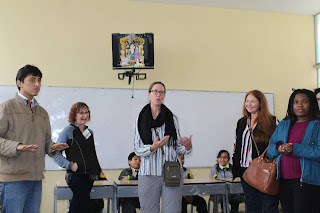We traveled to two schools in the Comas District which is far to the north, about fifteen miles from our hotel in Miraflores. The first school is named for Túpac Amaru, the last Sapa Inca who resisted the Spanish Conquistadores but was ultimately executed by them in 1572 in Cuzco. His is a rather dramatic story, especially of his capture and public execution, which was witnessed by crowds estimated at 10-15,000 people. "A multitude of Indians, who completely filled the square, saw that lamentable spectacle [and knew] that their lord and Inca was to die, they deafened the skies, making them reverberate with their cries and wailing,"according to Murúa, and the legality of the Spanish executing someone that they had previously recognized as a sovereign king set off a debate which eventually became the foundations of international law. John Heming's The Conquest of the Inca tells the history of this event and those leading up to it in great detail.
At Túpac Amaru we were greeted first by teachers and administrators with warm hugs and cheek kisses. Two former students lead us on tours of the campus, speaking fluent English and answering our questions. Students in classrooms were practically falling over themselves trying to say hello to us - when we approached a classroom we could hear their excitement rising. They were eager to practice their English and for many of them, we were the first Americans they'd met. After the quick tour, we had a round table activity where we sat with small groups of students and talked. These same activities were repeated at the next school.
Some observations on the schools:
- Although these schools were in a relatively poor area, many of the students had cellphones. I did not expect this. They were using Google Translate to look up things they did not know how to say in English.
- I got to speak a lot of Spanish with them which was super fun.
- These students were so proud of their school. They wear uniforms, which for most were cool track suits. I was coveting their jackets.
- Kids never once complained about their school or their teachers or the (lack of) resources. I would have liked to talk with the teachers more to understand their perspective.
- Kids are kids are kids. The things the kids wanted to talk about, the things that made them laugh, the issues they see in the world are the same as my students. Again, I am reminded that we are more similar than different, in spite of what the news media would have you believe.
- When asked what Peruvian foods we had tried and liked, they were so proud of their cuisine, especially ceviche and were so excited that we enjoyed it.
- Working in a school district that is underfunded by American standards, it was very interesting to visit a school that obviously receives less funding. Regardless, the students were proud and loved their school and loved learning. They definitely value education.
Some things that would be cool to implement at my school:
- Student leaders wore braided cords which designated them as holding various positions. One that I found most interesting was a designation for students who were to assist in an emergency, such as an earthquake. In the US, we have many drills to practice for a fire, a shooting, etc., but the responsibility is all on the teachers to ensure the safety of the students. What if there were students who shared that responsibility?
- There was a 15 minute recess period when all students were outside together. These students were playing soccer and being active, talking with friends and walking. Because the students stay in the classroom and the teacher moves from room to room here, this break was necessary. But what a great idea for the students to get some fresh air and have time to talk with one another. At my school students rush during their 6 minute passing period and some do not even have time to use a restroom because our campus is so spread out.















Yes kids are kids are kids. I love the idea of the braided cord for leadership roles, tell Mark and see what he thinks. Nancy
ReplyDeleteI am so enjoying your daily tales! Thanks for sending to your Mom and then she forwards to me! What a wonderful, exciting experience! Thank you Marion Davidson
ReplyDelete